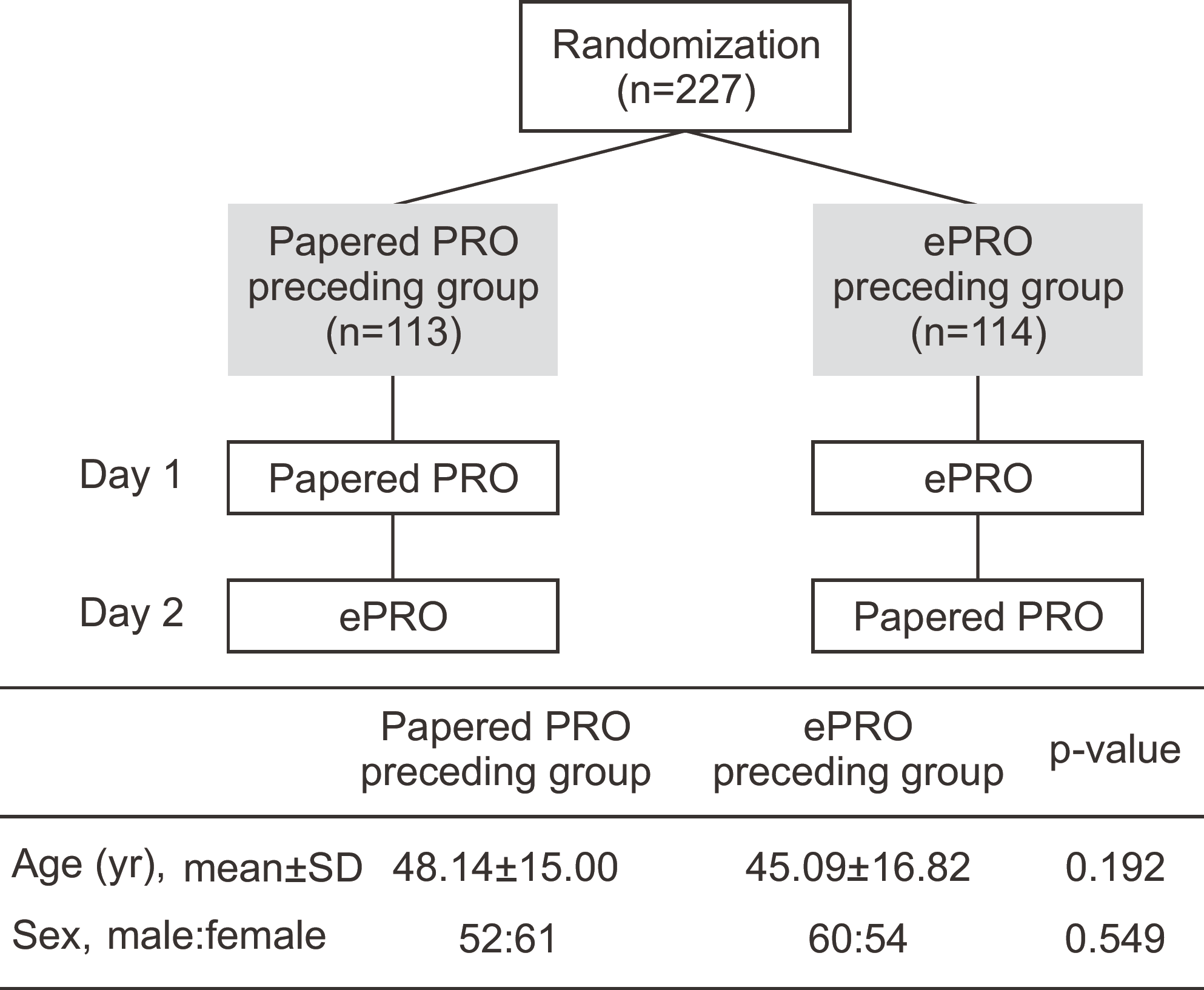Abstract
Purpose:
To evaluate the efficiency of the electronic foot function index (eFFI) through a prospective, random based, multi-institutional study.
Materials and Methods:
The study included 227 patients ranging in age from 20 to 79 years, visited for surgery in different 15 institutes, and agreed to volunteer. The patients were assigned randomly into a paper-based evaluated group (n=113) and tablet-based evaluated group (n=114). The evaluation was done on the day of hospital admission and the method was changed on the second day of surgery and re-evaluated. PADAS 2.0 (https://www.proscore.kr) was used as an electronic evaluation program.
Results:
There were no differences in age and sex in both groups. The intraclass correlation coefficient (ICC) evaluation revealed an eFFI ICC of 0.924, showing that both results were similar. The evaluation time was shorter in the tablet-based group than the paper-based group (paper vs tablet, 3.7±3.8 vs 2.3±1.3 minutes). Thirty-nine patients (17.2%) preferred to use paper and 131 patients (57.7%) preferred the tablet. Fifty-seven patients (25.1%) found both ways to be acceptable.
Go to : 
REFERENCES
2.Gwaltney CJ., Shields AL., Shiffman S. Equivalence of electronic and paper-and-pencil administration of patient-reported outcome measures: a meta-analytic review. Value Health. 2008. 11:322–33.

3.Coons SJ., Gwaltney CJ., Hays RD., Lundy JJ., Sloan JA., Revicki DA, et al. ISPOR ePRO Task Force. Recommendations on evidence needed to support measurement equivalence between electronic and paper-based patient-reported outcome (PRO) measures: ISPOR ePRO good research practices task force report. Value Health. 2009. 12:419–29.

4.Kim JB., Kwon MS., Kim JG., Yi Y., Lee WC., Ha JK, et al. The methods for foot function index and foot and ankle outcome score measurement: a comparison between paper-and-pencil method and electronic method. J Korean Foot Ankle Soc. 2017. 21:33–8.

5.In TS., Jung JH., Kim K., Jung KS., Cho HY. The reliability and validity of the Korean version of the foot function index for patients with foot complaints. J Phys Ther Sci. 2017. 29:53–6.

6.Budiman-Mak E., Conrad KJ., Roach KE. The foot function index: a measure of foot pain and disability. J Clin Epidemiol. 1991. 44:561–70.

10.Deyo RA., Andersson G., Bombardier C., Cherkin DC., Keller RB., Lee CK, et al. Outcome measures for studying patients with low back pain. Spine (Phila Pa 1976). 1994. 19(18 Suppl):2032S–2036S.

7.Yaffe M., Goyal N., Kokmeyer D., Merrell GA. The use of an iPad to collect patient-reported functional outcome measures in hand surgery. Hand (N Y). 2015. 10:522–8.
8.Ioannidis JP., Greenland S., Hlatky MA., Khoury MJ., Macleod MR., Moher D, et al. Increasing value and reducing waste in research design, conduct, and analysis. Lancet. 2014. 383:166–75.

11.Zbrozek A., Hebert J., Gogates G., Thorell R., Dell C., Molsen E, et al. Validation of electronic systems to collect patient-reported outcome (PRO) data-recommendations for clinical trial teams: report of the ISPOR ePRO systems validation good research practices task force. Value Health. 2013. 16:480–9.

Go to : 
 | Figure 1.Study design. PRO: patient-reported outcome, ePRO: electronic PRO, SD: standard deviation. |
Table 1.
Assessment of E cient (ICC) Equivalence b by Intraclass Correla ation Coeff
| ICC | 95% confidence interval | p-value | |
|---|---|---|---|
| Foot function index | 0.924 | 0.898∼0.944 | <0.001 |
Table 2.
Comparison of Completion Time
| Foot function index | Completion time (min) | p-value |
|---|---|---|
| Paper Tablet | 3.7±3.8 2.3±1.3 | <0.001 |




 PDF
PDF ePub
ePub Citation
Citation Print
Print



 XML Download
XML Download